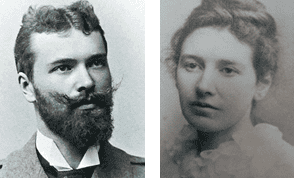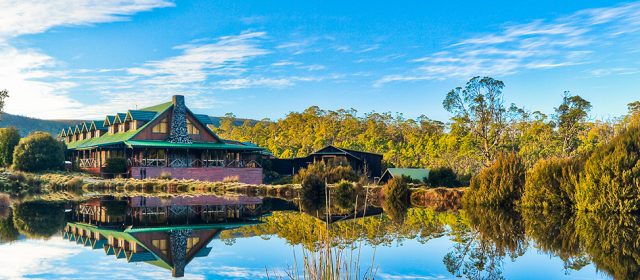History

“This must be a national park for the people for all time. It is magnificent and people must know about it and enjoy it.” Gustav Weindorfer, 1910*,exclaimed while climbing Cradle Mountain with his wife Kate and friends.
As a 25-year-old Austrian man, Gustav Weindorfer immigrated to Melbourne, Australia in 1899. Four years later he met 40-year-old Kate Cowle of Tasmania a mountain climber and botanist. Kate was a single woman with financial and personal independence. She and Gustav shared their botanical knowledge particularly of Victorian countryside and Mount Roland in Tasmania. Kate had climbed Mount Roland numerous times and in 1903 presented a scientific botanical paper in Melbourne which sparked their romance. They married in Tasmania on February 1st, 1906, and spent their five-week honeymoon camping on Mount Roland. They explored the mountain and collected many botanical specimens. Both were dedicated botanists and for them it seemed the ideal way to spend time together, sheltering in a canvas tent at night and cooking their meals over a camp fire. They explored the mountain and collected and stored many botanical specimens. It was from the top of Mount Roland that Kate pointed out the Cradle Mountain area to Gustav.
With Kate’s considerable wealth they were able to buy part of her brother’s farm, Lauriston, at Kindred, It was in sight of Mount Roland they named it Roland Lea. They were successful farmers but their dream was to visit and climb Cradle Mountain. It was not until 1909 that Gustav and a friend, Charlie Sutton, set out to explore Cradle Mountain. Both men were awed and amazed by the rugged splendour of the highlands. Upon returning to Roland Lea he and Kate started planning for her to go to Cradle and climb it which she did in January 1910*.
From this visit Gustav and Kate bought 200 acres each of the Valley and their neighbours the Smiths bought some 800 acres. This was to prevent further logging. In March 1912, on Kate’s parcel of land, Gustav commenced building Waldheim (Forest Home) from his own design. This single roofed hut was gradually extended to provide accommodation for friends and acquaintances with whom he and Kate wanted to share their love of this wildly beautiful land. The accommodation and facilities were primitive but when one considers everything was carried in by Weindorfer, including a large cast iron bath, over many miles of trackless bushland, it is extraordinary that the home was ever completed. In the summer of 1913, Gustav and Kate opened Waldheim for business, playing host to visitors prepared to forego contemporary conveniences in order to experience the magnificent highland scenery. Gustav continued to live at Waldheim even after the death of his beloved Kate in 1916 and though he was to accommodate many people at the chalet he earned the reputation for being a hermit.
On 16 May 1922, the land extending from Cradle Mountain south to Lake St. Clair (some 161,000 hectares) was proclaimed a National Park. The park came into being largely as a result of the considerable efforts made by Gustav, Kate and friends – they had campaigned over many years to have the government recognise the unique nature of the region and to preserve it for all to enjoy.
Gustav died on 4th May 1932 aged 58. He was buried in front of his treasured forest home and in 1938 a monument to Gustav was mounted on the site. Years later Waldheim had fallen into disrepair and the buildings were demolished by the National Parks & Wildlife Service. However, the public outcry over the loss of Waldheim was such that a replica – built from slabs and palings cut from King Billy Pine – was built on the site.
Today Waldheim is as it was left by the Weindorfers with rough-hewn walls and tiny rooms and the open veranda, where they and their friends sat, to look across Cradle Valley. It holds records of the early days of Cradle Mountain and the Weindorfer’s efforts to create a National Park to protect it for all time. Every New Year’s Day a memorial service is held at Waldheim to pay tribute to their vision.
Over the years the beauty of Cradle Mountain continued to attract visitors. In 1970 two brothers, Alec and Ossie Ellis, together with Marcus Dunstan and Richard Ruddle, all from established Tasmanian families, acquired 800 acres on the border of the Cradle Mountain/Lake St. Clair National Park. Here they would begin building a Lodge which would provide accommodation and meals for passing travellers – mostly keen bushwalkers and fishermen.
The setting chosen for the Lodge provided sweeping views and easy access to some of the most spectacular sites on the mountain. The two level Lodge featured a dining room with a huge fire place, a kitchen and a bar. Guest accommodation of seven rooms and two bathrooms were upstairs. The Pencil Pine Lodge, as it was known on opening in 1971, became increasingly successful and later individual cabins were added around the Lodge. Five guest cabins were built, each named after the native flora and fauna of the region – Currawong, Fagus, Hakea, Richea and Bauera. By the end of 1972 a staff cabin “The Greenhouse” had also been completed.
In 1984, Pencil Pine Lodge was acquired by a young and enthusiastic mainland couple. Without compromising the rustic charm of the original Pencil Pine Lodge, Simon and Anne Currant added thirty cabins to the property and upgraded lounge, bar and dining facilities. The property was renamed Cradle Mountain Lodge, but the name Pencil Pine was retained to designate the cabins.
In April 1988, Cradle Mountain Lodge was purchased by P&O Australian Resorts and the property underwent extensive expansion and refurbishment. The new Cradle Mountain Lodge was to become a wilderness retreat that worked in harmony with the unique World Heritage listed environment and provide guests with the comfort and modern conveniences they were searching for.
In 2004, Voyages Hotels and Resorts became custodians and under their ownership the Lodge continued a program of careful management of the Lodge and the magnificent surroundings, working with National Parks to upgrade various tracks and ensure the unique flora and fauna of the area is preserved.
The Lodge joined the Peppers Retreats, Resorts and Hotels portfolio in 2012 as part of their exclusive retreats collection. Today, locals and visitors alike are able to enjoy the beauty of the mountain wilderness area that first attracted Gustav and Kate Weindorfer and has since become recognised as ‘one of the world’s most precious places’.
Cradle Mountain Lodge is proudly owned by Elanor Investors Group. We look forward to welcoming you to Cradle Mountain Lodge to experience our hospitality while enjoying the wildlife and beauty of the pristine Tasmanian wilderness.


